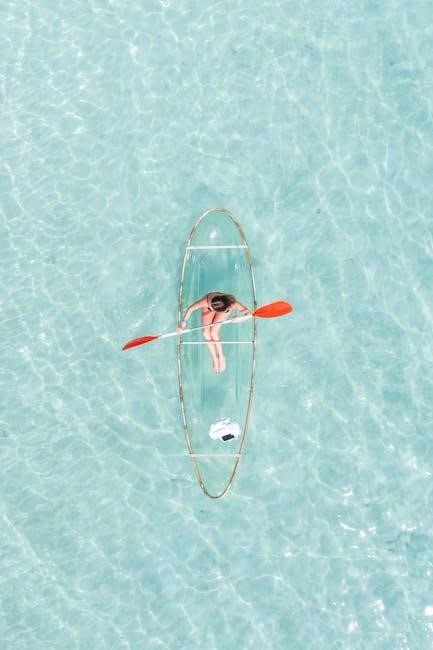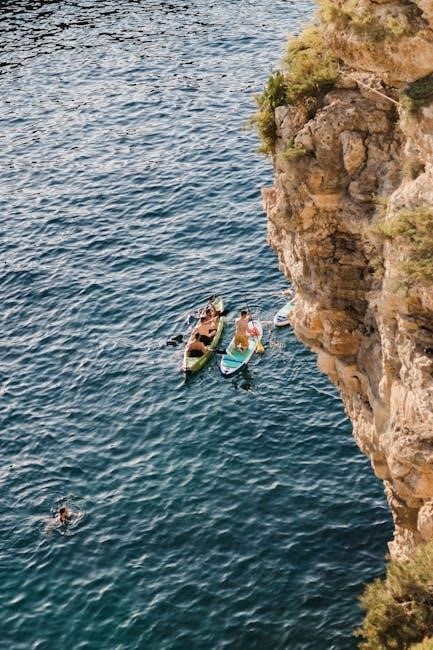Choosing the right kayak is essential for a enjoyable paddling experience. This guide helps you understand key factors like intended use, size, material, and features to make an informed decision.
1.1 Understanding the Importance of Choosing the Right Kayak
Choosing the right kayak ensures a safe and enjoyable paddling experience. Factors like size, weight capacity, material, and intended use significantly impact performance and comfort. A well-suited kayak maximizes stability, maneuverability, and efficiency, making every outing more rewarding. Prioritizing these elements helps tailor the kayak to your needs and paddling style.
1.2 Overview of the Guide
This guide provides a comprehensive overview of kayak purchasing, covering types, materials, size, and features. It explores intended use, budgeting, and testing options, ensuring readers make informed decisions tailored to their paddling needs and preferences. Practical advice and tips are included to simplify the selection process.
Types of Kayaks
From recreational to touring, fishing, inflatable, tandem, and whitewater, various kayak types cater to different paddling needs and preferences, ensuring there’s a model for every enthusiast.
2.1 Recreational Kayaks
Recreational kayaks are perfect for casual paddling on calm waters like lakes and slow rivers. They are lightweight, easy to maneuver, and feature a stable design, making them ideal for beginners or those seeking a relaxing experience. These kayaks often come in shorter lengths and are great for short trips or family use.
2.2 Touring Kayaks
Touring kayaks are designed for long-distance travel on open waters, offering excellent speed and tracking. They typically feature a sleek, narrow design with ample storage space for multi-day trips. These kayaks are ideal for experienced paddlers seeking adventure and efficiency on lakes, rivers, or coastal areas.
2.3 Fishing Kayaks
Fishing kayaks are designed specifically for anglers, offering stability and space for gear. They feature built-in rod holders, ample storage, and a spacious deck. Ideal for calm waters like ponds or lakes, these kayaks allow anglers to fish comfortably. Additional accessories like coolers or tackle boxes can enhance the fishing experience. Additionally, their design emphasizes comfort and ease of maneuverability, making long fishing trips enjoyable.
2.4 Inflatable Kayaks
Inflatable kayaks are lightweight, portable, and easy to store, making them ideal for beginners or those with limited space. They are durable and suitable for calm waters like lakes or rivers. While they offer excellent stability, they may lack the speed and handling of rigid kayaks in rough conditions.
2.5 Tandem Kayaks
Tandem kayaks are designed for two paddlers, offering a shared paddling experience. They are ideal for couples, families, or friends, promoting teamwork and social interaction. Generally longer and wider, they provide stability and ample storage. Coordination between paddlers is key for smooth handling, making them suitable for recreational or touring purposes on calm waters;
2.6 Whitewater Kayaks
Whitewater kayaks are designed for navigating rough, fast-moving waters like rapids. They are short, maneuverable, and highly responsive, with a rounded hull for quick turns. Made of durable, lightweight materials like fiberglass or carbon fiber, they are built for experienced paddlers seeking thrilling adventures in challenging river environments.
Considering Your Intended Use
Your kayaking goals and where you plan to paddle are crucial. Recreational, fishing, touring, or whitewater—each requires a kayak suited to the activity and water conditions.
3.1 Kayaking for Recreation
Recreational kayaking is ideal for calm waters like lakes, ponds, or slow-moving rivers. Stable and easy to maneuver, these kayaks offer comfort for casual paddling. They often feature spacious cockpits and ample storage for day trips, making them perfect for relaxation and exploring scenic areas without the need for advanced skills or speed;
3.2 Kayaking for Fishing
Fishing kayaks are designed for stability and functionality, ideal for anglers seeking calm waters like lakes or ponds. They often feature rod holders, ample storage for gear, and space to move freely. Consider models with built-in coolers or mounting points for accessories to enhance your fishing experience and ensure a comfortable day on the water.
3.3 Kayaking for Touring
Touring kayaks are designed for long-distance paddling on open water, offering efficiency and maneuverability. Look for a kayak with ample storage capacity for gear and a comfortable cockpit for extended trips. Consider the length and weight of the kayak, as these factors impact speed and stability, ensuring it meets your paddling experience and destination needs.
3.4 Kayaking for Whitewater
Whitewater kayaks are built for thrilling experiences on rapids, requiring durability and maneuverability. Choose a kayak with a sturdy, impact-resistant material like polyethylene. Consider the size and weight capacity to ensure stability in rough waters. Opt for a design with a rounded hull for better agility and safety features like a comfortable cockpit for easy control and quick exits.

Kayak Size and Weight Capacity
Kayak size and weight capacity are crucial for performance and stability. Larger kayaks offer more storage, while smaller ones improve maneuverability. Ensure the weight capacity matches your needs for optimal paddling efficiency and safety.
4.1 How Kayak Size Affects Handling
Kayak size significantly impacts handling, with longer kayaks offering better speed and tracking but reduced maneuverability. Shorter kayaks are more agile, ideal for tight spaces. The hull design also plays a role, influencing stability and responsiveness. Balancing these factors ensures a kayak that meets your paddling style and water conditions.
4.2 Understanding Weight Capacity
Weight capacity determines how much load a kayak can safely carry, including paddler and gear. Exceeding this limit can compromise stability and performance. Always consider your weight and equipment needs when selecting a kayak to ensure optimal safety and efficiency on the water.
4.3 Importance of Balance and Stability
Balancing your kayak ensures a stable and safe experience. A stable kayak allows better control, especially for beginners. Factors like hull design and kayak size greatly impact stability. Always consider your paddling environment and skill level when evaluating balance to ensure confidence and enjoyment on the water.

Materials and Construction
Understanding kayak materials and construction is key. Options include durable polyethylene, lightweight fiberglass, and high-performance carbon fiber. Each material impacts the kayak’s weight, durability, and performance on the water.
5.1 Polyethylene vs; Fiberglass vs. Carbon Fiber
Polyethylene kayaks are durable and affordable, making them ideal for recreational use. Fiberglass offers a lighter weight and better performance. Carbon fiber, while expensive, provides exceptional stiffness and speed, catering to serious paddlers seeking high-end performance and efficiency on the water.
5.2 Inflatable vs. Rigid Kayaks
Inflatable kayaks are lightweight, portable, and easy to store, ideal for calm waters or beginners. Rigid kayaks offer better durability, performance, and speed but are heavier and require more storage space. Choose based on your priorities—portability or performance—and intended paddling conditions for the best experience.
5.3 The Role of Construction Quality
Construction quality is crucial for a kayak’s performance and longevity. A well-made kayak ensures durability, consistent performance, and safety. High-quality construction materials and techniques enhance stability, speed, and maneuverability, making it essential to prioritize build excellence for a satisfying and secure paddling experience across various water conditions.
Key Features to Consider
Evaluating key features is essential for selecting the right kayak. Consider hull design, cockpit size, storage capacity, and accessories to ensure a comfortable and functional experience.
6.1 Hull Design and Its Impact
Hull design significantly influences a kayak’s performance. A rounded hull offers excellent maneuverability, while a flat hull provides stability. V-shaped hulls enhance tracking, making them ideal for touring. Consider your paddling style and water conditions to choose the most suitable hull type for your needs.
6.2 Cockpit Size and Comfort
Cockpit size and comfort are crucial for an enjoyable kayaking experience. A larger cockpit offers easy entry and exit, ideal for taller paddlers, while a smaller one provides better control. Look for adjustable seats and ample legroom to ensure comfort during long paddling sessions. Consider your size and preference when choosing.
6.3 Storage Capacity and Accessories
Storage capacity and accessories are vital for a practical kayaking experience. Look for hatches, compartments, and deck space to carry gear; Accessories like paddle holders, tie-downs, and fishing rod holders enhance functionality. Consider additional storage options for longer trips or specific activities, ensuring your kayak meets your needs for gear and organization;
Budget and Pricing
Setting a realistic budget is crucial when purchasing a kayak. Prices vary widely based on type, material, and features. Researching price ranges helps you find the best value.
7.1 Setting a Realistic Budget
Setting a realistic budget is key to purchasing a kayak. Start by assessing your needs and preferences. Research price ranges for different types and sizes. Consider additional costs like paddles, PFDs, and storage; Allocating a budget ensures you find a kayak that fits your lifestyle without overspending, providing long-term satisfaction and value.
7.2 Understanding Price Ranges
Kayak prices vary based on type, material, and features. Recreational models start around $300, while high-end touring or fishing kayaks can exceed $2,000. Understanding these ranges helps narrow your search. Consider durability, size, and included accessories when evaluating value for your investment.
7.3 Tips for Getting the Best Value
Assess your needs to avoid overspending. Compare models, features, and prices to find the best fit. Test paddle before buying to ensure comfort and performance. Consider used or last-season kayaks for savings. Set a budget and stick to it to maximize value for your investment.

Trying Before Buying
Test paddling is crucial to ensure comfort and performance. It allows you to assess handling, stability, and features firsthand. Attend demo days or rent before committing to a purchase.
8.1 The Importance of Test Paddling
Test paddling is essential to assess a kayak’s performance, comfort, and fit. It allows you to evaluate handling, stability, and maneuverability in real conditions. This hands-on experience helps ensure the kayak meets your needs and preferences, avoiding costly mistakes. Always prioritize test paddling before making a purchase.
8.2 Where to Find Demo Days
Demo days are events where manufacturers showcase kayaks for hands-on testing. Check local outdoor retailers, kayak manufacturers’ websites, or online forums for event listings. These events provide valuable opportunities to test multiple models, ensuring the best fit for your needs and preferences before purchasing.

Where to Buy
Kayaks can be purchased from retail stores, online marketplaces, or directly from manufacturers. Retail stores offer expert advice, while online platforms provide convenience and competitive pricing.
9.1 Retail Stores vs. Online Marketplaces
Retail stores offer personalized advice, hands-on experience, and immediate support. Online marketplaces provide convenience, wider selection, and competitive pricing. Consider visiting stores for expert guidance and testing kayaks before buying, while online platforms are ideal for comparing prices and reading reviews from other buyers.
9.2 Purchasing Used Kayaks
Buying a used kayak can save money but requires careful inspection. Check for damage, wear, and needed repairs. Research market value and negotiate prices. Platforms like Craigslist, Facebook Marketplace, and local classifieds are great for finding used kayaks. Ensure the seller provides maintenance history and test paddle before purchasing.

Accessories and Gear
Essential kayak accessories include paddles, PFDs, sprayskirts, and dry bags. Invest in high-quality gear to ensure safety, comfort, and performance on the water.
10.1 Essential Accessories for Kayaking
Essential accessories include a high-quality paddle, properly fitting PFD, sprayskirt, and dry bags for storage. Footrests, seat pads, and bungee cords enhance comfort and secure gear. A paddle float and bilge pump are crucial for safety. Ensure all accessories meet safety standards and fit your kayak model.
10.2 Paddles, PFDs, and Other Gear
Invest in a lightweight, durable paddle suited to your kayaking style. A properly fitting PFD is vital for safety, ensuring buoyancy and comfort. Additional gear includes a sprayskirt, dry bags, and a bilge pump for water removal. These essentials enhance performance, safety, and overall paddling enjoyment.

Maintenance and Upkeep
Regular cleaning, proper storage, and timely repairs are crucial for extending your kayak’s lifespan. Inspect for damage and address issues promptly to ensure optimal performance and safety.
11.1 Cleaning and Storage Tips
Regularly rinse your kayak with mild soap and water to remove dirt and grime. Store it in a cool, dry place, either upright or on a padded rack. Avoid direct sunlight to prevent material degradation. For inflatable kayaks, ensure they are completely dry before storing to prevent mold and mildew growth.
11.2 Repairing Your Kayak
Inspect your kayak regularly for cracks or punctures. For polyethylene kayaks, use a plastic welder or repair kit. Fiberglass models may require epoxy resin and cloth. Inflatable kayaks often need patch kits for punctures. Always follow manufacturer guidelines and address issues promptly to prevent further damage. Seek professional help for extensive repairs.
Safety Considerations
Always wear a properly fitting PFD and ensure your kayak has safety gear like a whistle and paddle float. Learn paddling techniques to maintain balance and avoid capsizing. Be prepared for emergencies with a first-aid kit and communication devices. Stay informed about weather conditions and water hazards to ensure a safe experience.
12.1 Safety Gear You Must Have
Essential safety gear includes a properly fitting PFD, whistle, and paddle float. Always carry a first-aid kit, flashlight, and communication devices. A spray skirt and bilge pump are crucial for wet conditions. Ensure visibility with reflective tape or lights, especially in low-light environments. Never paddle without these critical items for a safe experience.
12.2 Understanding Paddling Techniques
Mastering paddling techniques is crucial for efficiency and safety. Learn the forward stroke, reverse stroke, and turning methods. Practice proper posture, grip, and timing to maintain balance and control. Understanding these techniques enhances your ability to navigate various water conditions confidently and effectively, ensuring a enjoyable and safe kayaking experience.
12.3 Emergency Preparedness
Always carry a first-aid kit, whistle, and signaling devices. Pack extra clothing, a multi-tool, and a flashlight. Ensure your kayak has a bilge pump and consider a portable phone charger. Familiarize yourself with local emergency services and inform someone of your itinerary before heading out on the water.
Final tips ensure a successful purchase. Research, test paddle, and consider future needs. Encouraging you to start your kayaking journey with confidence and proper preparation.
13.1 Final Tips for a Successful Purchase
Test paddle before buying, set a realistic budget, and prioritize features like storage and comfort. Consider future needs and warranty options. Research retailers and read reviews to ensure a well-informed decision, guaranteeing a kayak that meets your paddling goals and enhances your water experiences for years to come.
13.2 Encouragement to Start Your Kayaking Journey
Embark on your kayaking adventure with confidence! Explore serene waters, discover hidden gems, and connect with nature. Whether paddling solo or with friends, kayaking offers freedom and joy. Start small, practice safety, and embrace the thrill of this rewarding hobby. Your journey awaits—grab a paddle and make unforgettable memories!